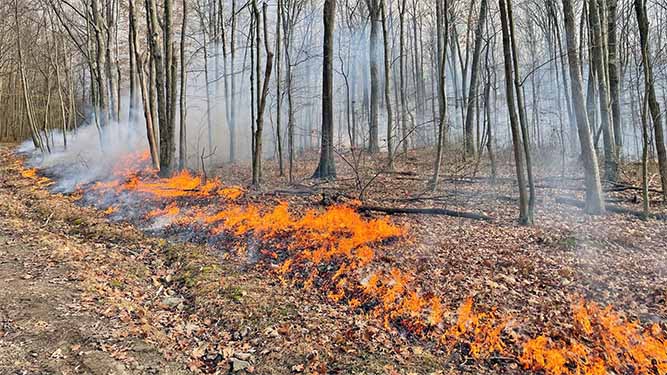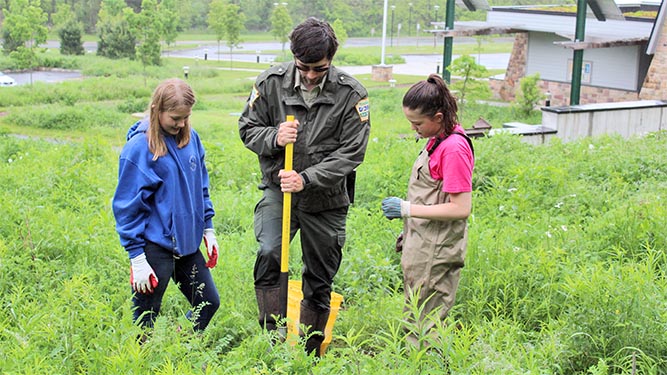State parks are for people, but they also provide a home for birds and wildlife, trees, and plants.
Picture in your mind the park you’ve visited mostly recently, and you’ll probably see trees and forests.
To protect these woods and landscapes for future generations, the Department of Conservation and Natural Resources Bureau of State Parks is taking a more hands-on approach to managing forests.
Impacts that people have had on forests have contributed to the decline of some forest-dependent wildlife species, including:
- Birds
- Bats
- Pollinators
- Small mammals
Forty percent of Pennsylvania’s species of greatest concern would benefit from direct management of forests and natural resources according to the State Wildlife Action Plan.
Health of Forests in Pennsylvania State Parks

Pennsylvania has always been known for its forests -- it’s in our name.
Research shows that the forests in state parks are simple rather than complex, meaning in many cases, the trees are of the same age, type, and size.
People impacted the forested landscape with harvesting, mining, and farming. Other impacts continue to occur from climate changing carbon emissions, deer browsing, invasive species, and development.
Conservation and reforestation have combatted some of these impacts, but many trees are now the same age and type.
There is a need to manage the forests in state parks to provide for a greater variety of ages, types, and sizes of trees and other plants.
This will help restore the complex habitats that used to be found in our dynamic forest systems.
Improving Pennsylvania State Park Forests

The Bureau of State Parks is taking a more hands-on approach to managing forests so that they are better able to provide quality park visitor experiences and thrive as habitat now and in the future.
The focus is on the health of the all the living things in an area (plants, animals, fungi, and microbes) and the nonliving things (air, water, and soil) rather than the size or monetary value of the trees.
Forestry goals for state parks include:
- Varied ages of trees
- Diverse tree species
- Diverse understory plant species
- Trees of varied diameters and height
- Connections to adjacent habitats such as wetlands and waterways
This work is being done in consultation with the Department of Conservation and Natural Resources Bureau of Forestry, the Pennsylvania Game Commission, and many other partners; and will include a variety of techniques.
- Prescribed fire involves setting a controlled fire to combat invasive species, improve regeneration, and recharge soil nutrients
- Thinning and harvesting some trees
- Planting native and diverse trees, forbs, and grasses
- Invasive and non-native species control through mechanical removal or herbicide treatments
- Specific conservation measures for species and habitats with special protections
In time, the intent is to create something like a patchwork quilt of interconnected forest “patches” of various ages, species, and management techniques.
Ecological Forestry at Ohiopyle and Laurel Ridge

Several significant forest restoration projects have begun in Pennsylvania state parks.
At Blue Knob, Laurel Ridge, and Ohiopyle state parks, projects including inventory, planning, and direct management were spurred with grant funding.
Additional comprehensive inventory and planning are underway at other parks, including Gouldsboro, Tobyhanna, Hickory Run, and Oil Creek state parks.
At times, work done within a restoration project area can be startling. Much like a home renovation project, the site gets messy before it gets better.
It takes time to see desired outcomes. The projects can be very noticeable to park visitors in specific areas.
However, wildlife frequently accepts the changes quickly and will begin to use its desired habitat as soon as its available.
This spring, a bird of special interest -- the cerulean warbler -- was identified at Laurel Ridge State Park in the forest management blocks. No cerulean warblers were found in baseline monitoring prior to the work there!
There was great excitement among Department of Conservation and Natural Resources staff and partners, as the populations of this forest bird have declined significantly since the 1960s.
Addressing Climate Change on Public Lands

As the caretaker of 124 state parks and 2.2 million acres of state forest, and the state’s primary conservation agency, the Department of Conservation and Natural Resources has a unique role and responsibility in helping the Commonwealth reduce and adapt to climate change.
Ecological forestry work at state parks is one of more than a hundred actions for climate resiliency outlined in the department’s Climate Change Adaptation and Mitigation Plan (PDF).
The department is in the process of updating its climate action plan, a draft of which is expected to be rolled out next year.